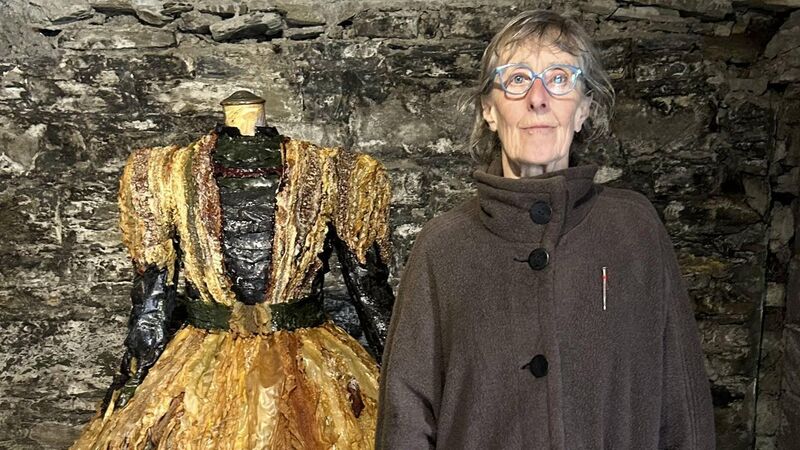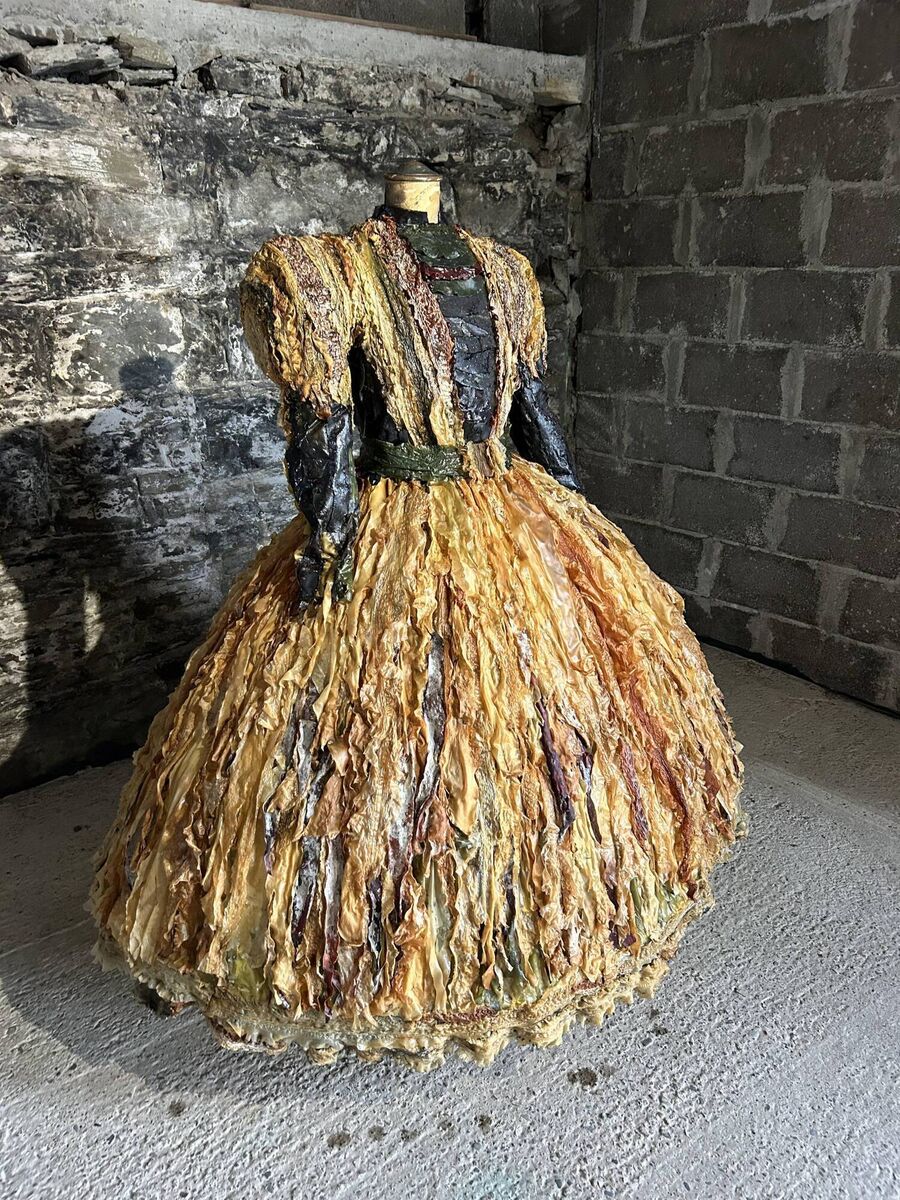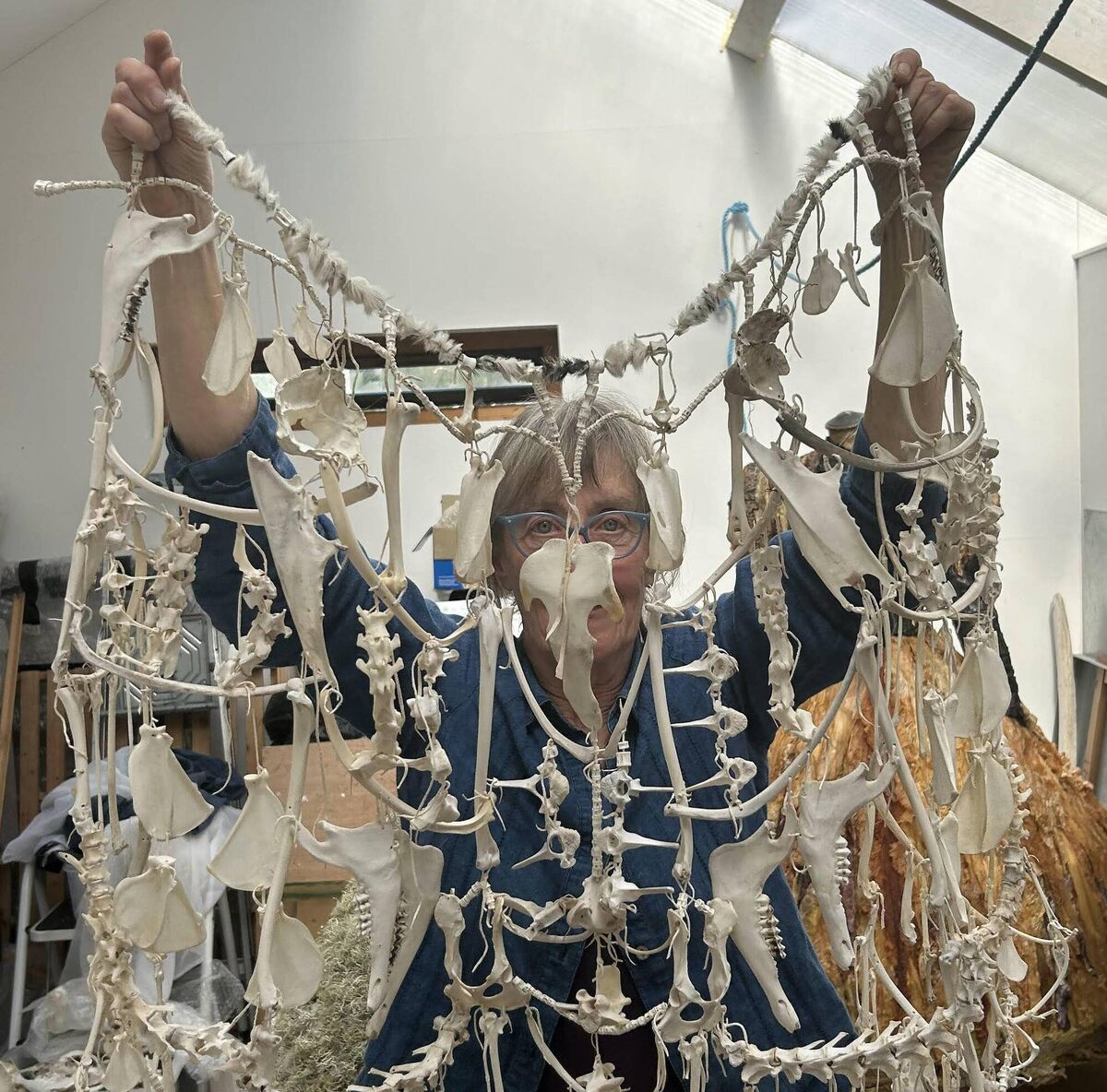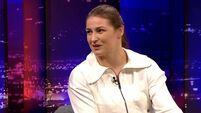Rachel Parry: Bone cloaks and seaweed dresses in West Cork

Rachel Parry with her Kelp Cailleach.
Living by the sea in Allihies, West Cork, the artist Rachel Parry has often created sculptural objects from materials – such as fishbones, jellyfish and seaweed – she has found along the shore. Cloaks and Pinholes, her forthcoming exhibition at the Allihies Copper Mine Museum, on the Beara peninsula in West Cork, features a series of pinhole photographs and two new sculptures – or ‘cloaks’, as she calls them – she has fashioned from similar materials.
Cloaks and Pinholes opens on October 10 as part of the Mine Museum’s Autumn School, which this year focuses on the Cailleach Bhéara. The Cailleach is one of the most ancient and revered figures in Irish mythology, a corn goddess from whom the clans of Munster claim descent. The subject of an epic Old Irish poem, she is remembered in many local legends, one of which describes how she turned herself to stone to avoid conversion to Christianity by an over-zealous priest. This is the form in which she survives today, overlooking the sea in Kilcatherine, in the neighbouring parish of Eyeries.
Parry sees correlations between the Cailleach Bhéara and St Brigid, both of whom straddle the pagan and Christian traditions in Ireland. “Brigid has to do with the spring and fertility, growing energy and the beginning of new life,” she says, “while the Cailleach could represent the transformation from life into darkness or sleep, or the underground. She’s often associated with winter, and the ending of the year.”
St Brigid has various associations with cloaks. In one legend, a local king agrees to grant her land on which to build a convent, as much as her cloak will cover, and is amazed when the garment grows miraculously to encompass several acres. In another, the Brat Bríde, a piece of cloth or handkerchef, is left outside on January 31, the Eve of St Brigid, to be blessed by her and used for protection and healing throughout the year.
This is partially what inspired Parry’s sculptures. “I’ve also learned that the word ‘cailleach’ could be derived from the Latin ‘pallium,’ a woollen cloak,” she says. “The landscape around where the Cailleach Bhéara stands is all rocks, covered in lichen. And I decided to use that in one of the cloaks. I wanted to make it as something I could wear and perform in, but also hold the shape of a rounded boulder. So it has a half-human/half-landscape form.”

Parry is a member of Na Cailleacha, which she describes as “a collective of women over the age of 70, who are looking at being visible as artists in our old age. There was a desire to represent age in my new work, so I made a second cloak out of bones, stitched together with leather.” This piece was also inspired by the story of how the Cailleach slaughtered a cow every year and kept its bones in her loft. When visitors tried to determine her age by counting the bones, they could never get to the end of them.
“Although I wouldn’t consider myself an eco-artist, the fact that I’m not casting things out of bronze actually matters to me,” says Parry. “I’m using materials that can be found all around. For this new cloak, I’ve used bones from whales and dolphins, a fox and various other animals and birds. There’s even a badger’s spine. The cloak is quite symmetrical. There’s two of everything. I went to a lot of trouble finding the right bones.” Parry’s interest in pinhole photography compelled her to complete a workshop with the Cork-based artist Harry Moore last year. The technique involves using a wooden or cardboard box as a camera, with a pinhole aperture that projects the image to be recorded onto film or photographic paper.
“I used matchboxes for some of the images,” says Parry. “I wrapped them in tape, to protect them from the rain, tied them to fence posts around the Cailleach Bhéara, and left them there for three weeks. For me, it was magical to have absolutely nothing to do with what they recorded. There’s a sort of energy around the Cailleach Bhéara, and in one of the images, there’s an aura of light that the camera has picked up on.”

Parry made another series of photographs in which, wearing her bone cloak, she disappears into an underground chamber in the nearby graveyard at Kilcatherine. “The idea was to become the Cailleach for a spell,” she says. “To wear the cloak and be outrageously old. That was the fun part. But then I had to experiment with so many different film grains and exposure times to record the images on black and white film. I made a darkroom in my shed, and developed the photographs myself.”
Parry also photographed her daughter Molly and granddaughter Alannah, who appear as ghost-like figures in the landscape. “I wanted Molly and Alannah to be almost transparent. It was Harry’s suggestion to photograph them first, and then put a piece of card in front of the lens. When I took the card away, the camera could go on photographing the landscape, and I could get the effect I was looking for.”
Parry has engaged with the Cailleach Bhéara as a subject in her work before. A few years ago, inspired by Paula Rego’s iconic painting Angel, she created Kelp Cailleach, a dress made of seaweed she collected on the shore. Parry produced a photograph that shows her wearing the dress, and holding two black-backed gull’s wings in place of the sword and the sponge in Rego’s painting. She showed the photograph as part of Na Cailleacha’s exhibition In Reference to Paula Rego at the Dock in Carrick-on-Shannon in the spring of 2023, and last month she showed the dress itself at Bere Island Arts Festival.
She now plans to return it to the sea. “I’ll probably do that at Trá an Phiarla,” she says. “It’s the place near here where I swim most days. I had planned on doing it on my own, walking into the water in the dress, and letting it fall apart around me. But there’s been a lot of interest, so now I expect I’ll do it as a performance, and record it on film.”
Parry has also been collecting ‘mermaids’ purses’, the shark egg cases one finds discarded along the shore, for use in a future sculptural project. “At the moment, my intention is to make a portal, like a big archway that people could walk through one at a time. And each of the purses would have inside it someone’s vision for a clean ocean, written in seaweed ink on paper. That’s a project I hope to collaborate on next year with a couple of marine scientists.”
- Rachel Parry, Cloaks and Pinholes will be opened by poet Paddy Bushe at 6.30pm October 10 as part of the Allihies Autumn School at Allihies Copper Mine Museum.
- Further information: rachelparryartist.com; accm.ie





